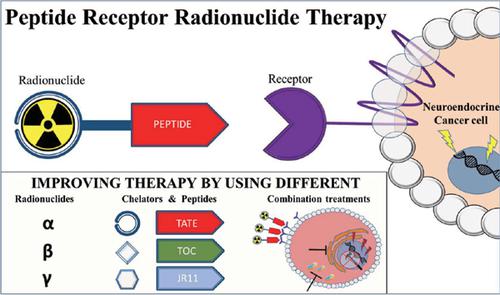Current Topics in Medicinal Chemistry ( IF 2.9 ) Pub Date : 2020-11-30 , DOI: 10.2174/1568026620666200226104652 Danny Feijtel 1 , Marion de Jong 1 , Julie Nonnekens 1

|
Peptide receptor radionuclide therapy (PRRT) is a highly effective anti-cancer treatment modality for patients with non-resectable, metastasized neuroendocrine tumors (NETs). During PRRT, specific receptors that are overexpressed on the cancer cells are targeted with a peptide labeled with a DNA-damaging radionuclide. Even though PRRT is a powerful treatment for metastasized NET patients, the majority still cannot be cured at this stage of the disease. Hence, many investigators focus on improving the therapeutic efficacy of this therapy. Improving PRRT can, for example, be achieved by using other radionuclides with different physical properties, by combining PRRT with radiosensitizing agents or by radiolabeling peptides with different characteristics. However, due to lack of extensive knowledge of radiobiological responses of cancer cells to PRRT, biological parameters that influence absorbed dose or that might even elicit insensitivity to therapy remain elusive and the context in which these improvements will be successful warrants further investigation. In this review, we will discuss the development of PRRT, its clinical merits in current treatment and future perspectives. We will highlight different radionuclides and their benefits and pitfalls, as well as different peptide-conjugates that hold these radionuclides. We will zoom in on the latest developments regarding combinatorial treatments and how investigators from different disciplines such as dosimetry and radiobiology are now joining forces to improve PRRT for NETs.
中文翻译:

肽受体放射性核素治疗:回顾,展望
肽受体放射性核素疗法 (PRRT) 是一种非常有效的抗癌治疗方式,适用于不可切除的转移性神经内分泌肿瘤 (NET)。在 PRRT 过程中,在癌细胞上过度表达的特定受体会被一种标记有破坏 DNA 的放射性核素的肽靶向。尽管 PRRT 对转移性 NET 患者来说是一种强有力的治疗方法,但大多数在疾病的这个阶段仍然无法治愈。因此,许多研究人员专注于提高这种疗法的治疗效果。例如,可以通过使用具有不同物理特性的其他放射性核素、通过将 PRRT 与放射增敏剂结合或通过放射性标记具有不同特性的肽来改善 PRRT。然而,由于缺乏对癌细胞对 PRRT 的放射生物学反应的广泛了解,影响吸收剂量或什至可能导致对治疗不敏感的生物参数仍然难以捉摸,这些改进将成功的背景值得进一步研究。在这篇综述中,我们将讨论 PRRT 的发展、其在当前治疗中的临床优势和未来前景。我们将重点介绍不同的放射性核素及其优点和缺陷,以及包含这些放射性核素的不同肽偶联物。我们将重点关注有关组合治疗的最新进展,以及来自不同学科(如剂量学和放射生物学)的研究人员现在如何联手改进 NET 的 PRRT。我们将重点介绍不同的放射性核素及其优点和缺陷,以及包含这些放射性核素的不同肽偶联物。我们将重点关注有关组合治疗的最新进展,以及来自不同学科(如剂量学和放射生物学)的研究人员现在如何联手改进 NET 的 PRRT。我们将重点介绍不同的放射性核素及其优点和缺陷,以及包含这些放射性核素的不同肽偶联物。我们将重点关注有关组合治疗的最新进展,以及来自不同学科(如剂量学和放射生物学)的研究人员现在如何联手改进 NET 的 PRRT。











































 京公网安备 11010802027423号
京公网安备 11010802027423号